Input interpretation

Cl_2 (chlorine) + NaI (sodium iodide) ⟶ I_2 (iodine) + NaCl (sodium chloride)
Balanced equation
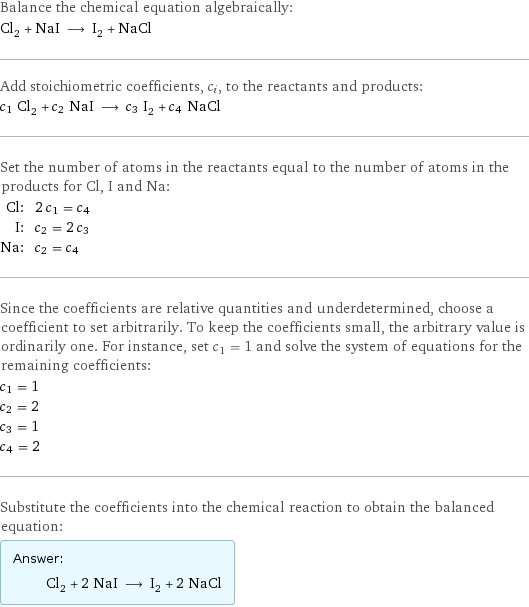
Balance the chemical equation algebraically: Cl_2 + NaI ⟶ I_2 + NaCl Add stoichiometric coefficients, c_i, to the reactants and products: c_1 Cl_2 + c_2 NaI ⟶ c_3 I_2 + c_4 NaCl Set the number of atoms in the reactants equal to the number of atoms in the products for Cl, I and Na: Cl: | 2 c_1 = c_4 I: | c_2 = 2 c_3 Na: | c_2 = c_4 Since the coefficients are relative quantities and underdetermined, choose a coefficient to set arbitrarily. To keep the coefficients small, the arbitrary value is ordinarily one. For instance, set c_1 = 1 and solve the system of equations for the remaining coefficients: c_1 = 1 c_2 = 2 c_3 = 1 c_4 = 2 Substitute the coefficients into the chemical reaction to obtain the balanced equation: Answer: | | Cl_2 + 2 NaI ⟶ I_2 + 2 NaCl
Structures

+ ⟶ +
Names

chlorine + sodium iodide ⟶ iodine + sodium chloride
Reaction thermodynamics
Enthalpy
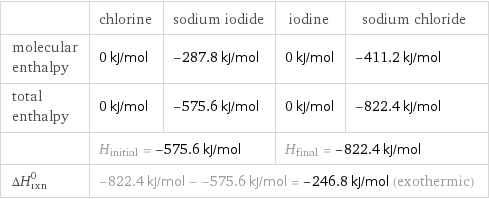
| chlorine | sodium iodide | iodine | sodium chloride molecular enthalpy | 0 kJ/mol | -287.8 kJ/mol | 0 kJ/mol | -411.2 kJ/mol total enthalpy | 0 kJ/mol | -575.6 kJ/mol | 0 kJ/mol | -822.4 kJ/mol | H_initial = -575.6 kJ/mol | | H_final = -822.4 kJ/mol | ΔH_rxn^0 | -822.4 kJ/mol - -575.6 kJ/mol = -246.8 kJ/mol (exothermic) | | |
Gibbs free energy
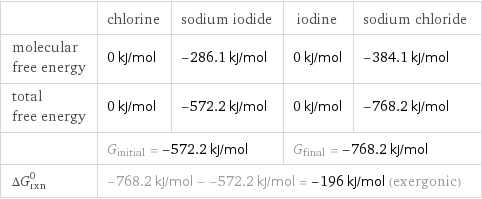
| chlorine | sodium iodide | iodine | sodium chloride molecular free energy | 0 kJ/mol | -286.1 kJ/mol | 0 kJ/mol | -384.1 kJ/mol total free energy | 0 kJ/mol | -572.2 kJ/mol | 0 kJ/mol | -768.2 kJ/mol | G_initial = -572.2 kJ/mol | | G_final = -768.2 kJ/mol | ΔG_rxn^0 | -768.2 kJ/mol - -572.2 kJ/mol = -196 kJ/mol (exergonic) | | |
Entropy
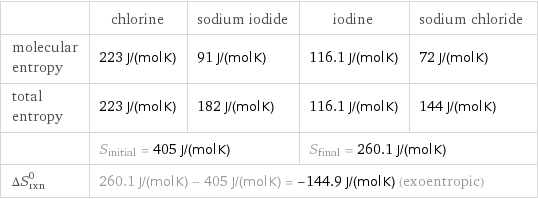
| chlorine | sodium iodide | iodine | sodium chloride molecular entropy | 223 J/(mol K) | 91 J/(mol K) | 116.1 J/(mol K) | 72 J/(mol K) total entropy | 223 J/(mol K) | 182 J/(mol K) | 116.1 J/(mol K) | 144 J/(mol K) | S_initial = 405 J/(mol K) | | S_final = 260.1 J/(mol K) | ΔS_rxn^0 | 260.1 J/(mol K) - 405 J/(mol K) = -144.9 J/(mol K) (exoentropic) | | |
Equilibrium constant
![Construct the equilibrium constant, K, expression for: Cl_2 + NaI ⟶ I_2 + NaCl Plan: • Balance the chemical equation. • Determine the stoichiometric numbers. • Assemble the activity expression for each chemical species. • Use the activity expressions to build the equilibrium constant expression. Write the balanced chemical equation: Cl_2 + 2 NaI ⟶ I_2 + 2 NaCl Assign stoichiometric numbers, ν_i, using the stoichiometric coefficients, c_i, from the balanced chemical equation in the following manner: ν_i = -c_i for reactants and ν_i = c_i for products: chemical species | c_i | ν_i Cl_2 | 1 | -1 NaI | 2 | -2 I_2 | 1 | 1 NaCl | 2 | 2 Assemble the activity expressions accounting for the state of matter and ν_i: chemical species | c_i | ν_i | activity expression Cl_2 | 1 | -1 | ([Cl2])^(-1) NaI | 2 | -2 | ([NaI])^(-2) I_2 | 1 | 1 | [I2] NaCl | 2 | 2 | ([NaCl])^2 The equilibrium constant symbol in the concentration basis is: K_c Mulitply the activity expressions to arrive at the K_c expression: Answer: | | K_c = ([Cl2])^(-1) ([NaI])^(-2) [I2] ([NaCl])^2 = ([I2] ([NaCl])^2)/([Cl2] ([NaI])^2)](../image_source/fd5f5f09a31ad7484fb07bc55bb03e7e.png)
Construct the equilibrium constant, K, expression for: Cl_2 + NaI ⟶ I_2 + NaCl Plan: • Balance the chemical equation. • Determine the stoichiometric numbers. • Assemble the activity expression for each chemical species. • Use the activity expressions to build the equilibrium constant expression. Write the balanced chemical equation: Cl_2 + 2 NaI ⟶ I_2 + 2 NaCl Assign stoichiometric numbers, ν_i, using the stoichiometric coefficients, c_i, from the balanced chemical equation in the following manner: ν_i = -c_i for reactants and ν_i = c_i for products: chemical species | c_i | ν_i Cl_2 | 1 | -1 NaI | 2 | -2 I_2 | 1 | 1 NaCl | 2 | 2 Assemble the activity expressions accounting for the state of matter and ν_i: chemical species | c_i | ν_i | activity expression Cl_2 | 1 | -1 | ([Cl2])^(-1) NaI | 2 | -2 | ([NaI])^(-2) I_2 | 1 | 1 | [I2] NaCl | 2 | 2 | ([NaCl])^2 The equilibrium constant symbol in the concentration basis is: K_c Mulitply the activity expressions to arrive at the K_c expression: Answer: | | K_c = ([Cl2])^(-1) ([NaI])^(-2) [I2] ([NaCl])^2 = ([I2] ([NaCl])^2)/([Cl2] ([NaI])^2)
Rate of reaction
![Construct the rate of reaction expression for: Cl_2 + NaI ⟶ I_2 + NaCl Plan: • Balance the chemical equation. • Determine the stoichiometric numbers. • Assemble the rate term for each chemical species. • Write the rate of reaction expression. Write the balanced chemical equation: Cl_2 + 2 NaI ⟶ I_2 + 2 NaCl Assign stoichiometric numbers, ν_i, using the stoichiometric coefficients, c_i, from the balanced chemical equation in the following manner: ν_i = -c_i for reactants and ν_i = c_i for products: chemical species | c_i | ν_i Cl_2 | 1 | -1 NaI | 2 | -2 I_2 | 1 | 1 NaCl | 2 | 2 The rate term for each chemical species, B_i, is 1/ν_i(Δ[B_i])/(Δt) where [B_i] is the amount concentration and t is time: chemical species | c_i | ν_i | rate term Cl_2 | 1 | -1 | -(Δ[Cl2])/(Δt) NaI | 2 | -2 | -1/2 (Δ[NaI])/(Δt) I_2 | 1 | 1 | (Δ[I2])/(Δt) NaCl | 2 | 2 | 1/2 (Δ[NaCl])/(Δt) (for infinitesimal rate of change, replace Δ with d) Set the rate terms equal to each other to arrive at the rate expression: Answer: | | rate = -(Δ[Cl2])/(Δt) = -1/2 (Δ[NaI])/(Δt) = (Δ[I2])/(Δt) = 1/2 (Δ[NaCl])/(Δt) (assuming constant volume and no accumulation of intermediates or side products)](../image_source/d491c73744e0795bcad18d1151ac7478.png)
Construct the rate of reaction expression for: Cl_2 + NaI ⟶ I_2 + NaCl Plan: • Balance the chemical equation. • Determine the stoichiometric numbers. • Assemble the rate term for each chemical species. • Write the rate of reaction expression. Write the balanced chemical equation: Cl_2 + 2 NaI ⟶ I_2 + 2 NaCl Assign stoichiometric numbers, ν_i, using the stoichiometric coefficients, c_i, from the balanced chemical equation in the following manner: ν_i = -c_i for reactants and ν_i = c_i for products: chemical species | c_i | ν_i Cl_2 | 1 | -1 NaI | 2 | -2 I_2 | 1 | 1 NaCl | 2 | 2 The rate term for each chemical species, B_i, is 1/ν_i(Δ[B_i])/(Δt) where [B_i] is the amount concentration and t is time: chemical species | c_i | ν_i | rate term Cl_2 | 1 | -1 | -(Δ[Cl2])/(Δt) NaI | 2 | -2 | -1/2 (Δ[NaI])/(Δt) I_2 | 1 | 1 | (Δ[I2])/(Δt) NaCl | 2 | 2 | 1/2 (Δ[NaCl])/(Δt) (for infinitesimal rate of change, replace Δ with d) Set the rate terms equal to each other to arrive at the rate expression: Answer: | | rate = -(Δ[Cl2])/(Δt) = -1/2 (Δ[NaI])/(Δt) = (Δ[I2])/(Δt) = 1/2 (Δ[NaCl])/(Δt) (assuming constant volume and no accumulation of intermediates or side products)
Chemical names and formulas
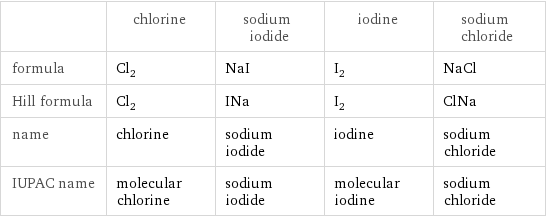
| chlorine | sodium iodide | iodine | sodium chloride formula | Cl_2 | NaI | I_2 | NaCl Hill formula | Cl_2 | INa | I_2 | ClNa name | chlorine | sodium iodide | iodine | sodium chloride IUPAC name | molecular chlorine | sodium iodide | molecular iodine | sodium chloride
Substance properties

| chlorine | sodium iodide | iodine | sodium chloride molar mass | 70.9 g/mol | 149.89424 g/mol | 253.80894 g/mol | 58.44 g/mol phase | gas (at STP) | solid (at STP) | solid (at STP) | solid (at STP) melting point | -101 °C | 661 °C | 113 °C | 801 °C boiling point | -34 °C | 1300 °C | 184 °C | 1413 °C density | 0.003214 g/cm^3 (at 0 °C) | 3.67 g/cm^3 | 4.94 g/cm^3 | 2.16 g/cm^3 solubility in water | | | | soluble dynamic viscosity | | 0.0010446 Pa s (at 691 °C) | 0.00227 Pa s (at 116 °C) | odor | | | | odorless
Units
